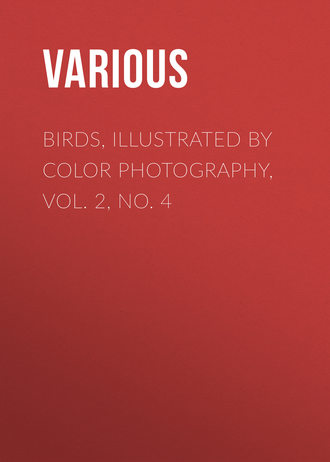 полная версия
полная версияBirds, Illustrated by Color Photography, Vol. 2, No. 4
I only attack my enemies, – the Hawks, Owls, Eagles, Crows, Jays, and Cuckoos. They would destroy my young family if I did not drive them away. Mr. Crow especially is a great thief. When my mate is on her nest I keep a sharp lookout, and when one of my enemies approaches I give a shrill cry, rise in the air, and down I pounce on his back; I do this more than once, and how I make the feathers fly!
The little hawks and crows I never attack, and yet they call me a bully. Sometimes I do go for a Song-bird or a Robin, but only when they come too near my nest. People wonder why I never attack the cunning Catbird. I’ll never tell them, you may be sure!
To what family do I belong? To a large family called Flycatchers. Because some Kings are tyrants I suppose, they call me the Tyrant Flycatcher. Look for me next summer on top of a wire fence or dead twig of a tree, and watch me, every few minutes, dash into the air, seize a passing insect, and then fly back to the same perch again.
Any other names? Yes, some folks call me the Bee Bird or Bee Martin. Once in awhile I change my diet and do snap up a bee! but it is always a drone, not a honey-bee. Some ill-natured people say I choose the drones because they can’t sting, and not because they are tramp bees and will not work.
Sing? Yes, when my mate is on her nest I please her with a soft pretty song, at other times my call-note is a piercing Kyrie-K-y-rie! I live with you only in the summer. When September comes I fly away to a warmer climate.
SUMMARY
Page 123.
BLACKBURNIAN WARBLER.—Dendroica blackburniæ.
Range – Eastern North America; breeds from northern Minnesota and southern Maine northward to Labrador and southward along the Alleghenies to South Carolina; winters in the tropics.
Nest – Of fine twigs and grasses, lined with grasses and tendrils, in coniferous trees, ten to forty feet up.
Eggs – Four, grayish white or bluish white, distinctly and obscurely spotted, speckled, and blotched with cinnamon brown or olive brown.
Page 128.
AMERICAN GOLDFINCH.—Spinus tristis. Other names: “Yellow-bird,” “Thistle-bird.”
Range – Eastern North America; breeds from South Carolina to southern Labrador; winters from the northern United States to the Gulf.
Nest – Externally, of fine grasses, strips of bark and moss, thickly lined with thistle down; in trees or bushes, five to thirty feet up.
Eggs – Three to six, pale bluish white.
Page 131.
CHIMNEY SWIFT.—Chætura pelagica. Other name: “Chimney Swallow.”
Range – Eastern North America; breeds from Florida to Labrador; winters in Central America.
Nest – A bracket-like basket of dead twigs glued together with saliva, attached to the wall of a chimney, generally about ten feet from the top, by the gummy secretions of the bird’s salivary glands.
Eggs – Four to six, white.
Page 135.
HORNED LARK.—Otocoris alpestris. Other name: “Shore Lark.”
Range – Breeds in northern Europe, Greenland, Newfoundland, Labrador, and Hudson Bay region; southward in winter into eastern United States to about latitude 35°.
Nest – Of grasses, on the ground.
Eggs – Three or four, pale bluish or greenish white, minutely and evenly speckled with pale grayish brown.
Page 140.
SAPSUCKER, YELLOW-BELLIED.—Sphyrapicus varius.
Range – Eastern North America; breeds from Massachusetts northward, and winters from Virginia to Central America.
Nest – About forty feet from the ground.
Eggs – Five to seven.
Page 141.
WARBLING VIREO.—Vireo gilvus. Other name: “Yellow-throated Vireo.”
Range – North America; breeds as far north as the Hudson Bay region; winters in the tropics.
Nest – Pensile, of grasses and plant fibres, firmly and smoothly interwoven, lined with fine grasses, suspended from a forked branch eight to forty feet up.
Eggs – Three or four, white, with a few specks or spots of black umber, or rufous-brown, chiefly about the larger end.
Page 146.
WOOD PEWEE.—Contopus Virens.
Range – Eastern North America; breeds from Florida to Newfoundland; winters in Central America.
Nest – Compact and symmetrical, of fine grasses, rootlets and moss, thickly covered with lichens, saddled on a limb, twenty to forty feet up.
Eggs – Three or four, white, with a wreath of distinct and obscure markings about the larger end.
Page 150.
SNOWFLAKE.—Plectrophenax nivalis. Other name: “Snow Bunting.”
Range – Northern parts of northern hemisphere, breeding in the arctic regions; in North America, south in Winter into the northern United States, irregularly to Georgia, southern Illinois, and Kansas.
Nest – Of grasses, rootlets, and moss, lined with finer grasses and feathers, on the ground.
Eggs – Four to seven, pale bluish white, thinly marked with umber or heavily spotted or washed with rufous-brown.
Page 153.
JUNCO—Junco hyemalis. Other name: “Snowbird.”
Range – North America; breeds from northern Minnesota to northern New York and southward along the summits of the Alleghenies to Virginia; winters southward to the Gulf States.
Nest – Of grasses, moss, and rootlets, lined with fine grasses and long hairs, on or near the ground.
Eggs – Four or five, white or bluish white, finely or evenly speckled or spotted, sometimes heavily blotched at the larger end with rufous-brown.
Page 158.
KINGBIRD.—Tyrannus tyrannus.
Range – North America north to New Brunswick and Manitoba; rare west of the Rocky Mountains; winters in Central and South America.
Nest – Compact and symmetrical, of weed-stocks, grasses, and moss, lined with plant down, fine grasses, and rootlets, generally at the end of a branch fifteen to twenty-five feet from the ground.
Eggs – Three to five, white, spotted with umber.











